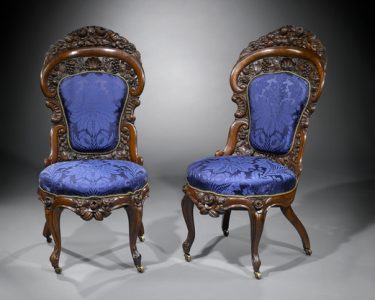
Few craftsmen in history leave such an indelible mark on their craft that their name becomes synonymous with all other works of that style.
Thomas Chippendale was one such artisan as was Louis Comfort Tiffany a century and a half later. Another such name is that of John Henry Belter, a German immigrant to America whose extraordinary technical innovations and masterful artistry quite literally changed the face of furniture making during the mid-1800s. For almost 100 years after his death, any furniture of the period exhibiting an exuberance of carving or the styling of the Rococo Revival was dubbed "Belter" furniture. It wasn't until the 1960s that the true genius of John Henry Belter was finally realized, when experts began making important distinctions between the superior work of Belter and the lesser works of his competitors.

Belter emigrated to America from Germany as a young man in 1833 and became a naturalized citizen by 1839. He was already an accomplished furniture maker when he arrived in New York having been apprenticed to a furniture maker in Stüttgart, Germany. Belter came to America with little more than talent and ambition and by 1844 he had used both to become a well-respected cabinetmaker, even showing his works at the prestigious New York Exhibition of the Industry of All Nations in 1853. By 1854, he oversaw the building of his five-story factory in the heart of New York City.
Perhaps more than anything, Belter is remembered for his pioneering work and innovative process for laminating wood. Though he did not invent the process of laminating wood, Belter had discovered an unusual method of cutting through incredibly strong laminated pieces, allowing him to create extraordinary carvings without sacrificing strength and durability. During the course of his career, Belter would apply for and receive several important patents that would go on to define much of his work. First, in 1847, was the patent for "Machinery for Sawing Arabesque Chairs." In 1856, Belter received a patent for a "Bedstead," unusual in its construction allowing for quick disassembly in the case of fires. The bed also had no "intricate recesses about the joints and fastenings...notorious as hiding places for bugs." In 1858, Belter received perhaps his most important patent for "improvement in the method of manufacturing furniture" which refined the process for achieving laminated construction. Belter had been using his improved process for several years and perhaps only patented it to thwart his competitors.

Each of these patents protected Belter's inventions and allowed him to produce the extraordinary works that are so cherished today. Openwork carving of unbelievable complexity characterized his chairs and sofas, majestic beds were adorned with graceful curves and impressive crests and case furniture boasted incomparable quality of both material and craftsmanship. These are the hallmarksof John Henry Belter. Indeed, the firm of Dunn and Bradstreet recognized Belter's talent and business sense and thought that he was a good risk who could be counted on to pay his debts. But they went on to say that the quality of furniture that Belter produced was much too high for the business to be profitable!
Their assessment may have had some merit. Belter enjoyed the patronage of many wealthy clients and he never wavered in his commitment to produce the very best. Indeed Belter never compromised quality to satisfy the demands of customers who were unwilling to pay for the very best. Today, his work is recognized for that quality and for its artistic interpretation of the Rococo Revival. And, though few of Belter's pieces are marked or labeled, it is hard to mistake the sure hand of this master craftsman.
John Henry Belter died in 1863 from a form of tuberculosis when he was 59 years old, leaving behind a widow and five children. His in-laws tried to carry on the family business, but were unable to capture the genius that Belter had taken with him. The company went bankrupt just two years following his death. Though he worked in America for just under 30 years, he almost single-handedly bridged the gap between the craftsmanship of the 18th century and the profound new technologies of the 19th century. His work is extremely rare and highly collectible today.
Browse the rest of our antique seating collection today.






